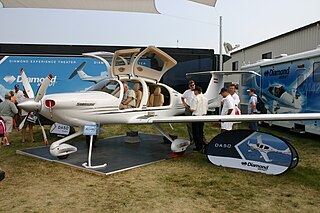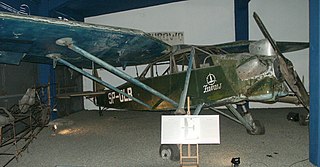
The Ilyushin Il-18 is a large turboprop airliner that first flew in 1957 and became one of the best known Soviet aircraft of its era. The Il-18 was one of the world's principal airliners for several decades and was widely exported. Due to the aircraft's durability, many examples achieved over 45,000 flight hours and the type remains operational in both military and civilian capacities. The Il-18's successor was the longer-range Ilyushin Il-62.

The Antonov An-10 Ukraina is a four-engined turboprop passenger transport aircraft designed in the Soviet Union.

The PZL M-15 was a jet-powered sesquiplane designed and manufactured by the Polish aircraft company WSK PZL-Mielec for agricultural aviation. In reference to both its strange looks and relatively loud jet engine, the aircraft was nicknamed Belphegor, after the noisy demon.

The Aero L-60 Brigadýr was a small, high-wing propeller-driven Czechoslovakian STOL utility aircraft developed for both civil and military use. A prototype, designated XL-60, with Argus As 10C engine, first flew on December 24, 1953, but it was not successful. The plane was thoroughly redesigned and the second improved prototype, with M-208B flat-six engine, flew on June 8, 1954. The aircraft's configuration bears a strong resemblance to the Fieseler Fi 156 "Storch" licence-produced in Czechoslovakia during and after World War II, and which this aircraft was intended to replace. By the end of production in 1960, 273 had been built by Aero, including an improved version, the L-160 with an all-metal tail.

The Vickers VC.1 Viking is a British twin-engine short-range airliner derived from the Vickers Wellington bomber and built by Vickers-Armstrongs Limited at Brooklands near Weybridge in Surrey. After the Second World War, the Viking was an important airliner with British airlines, pending the development of turboprop aircraft like the Viscount. An experimental airframe was fitted with Rolls-Royce Nene turbojets and first flown in 1948 as the world's first pure jet transport aircraft. Military developments were the Vickers Valetta and the Vickers Varsity.

The IAI Westwind is a business jet initially produced by Aero Commander as the 1121 Jet Commander. Powered by twin GE CJ610 turbojets, it first flew on January 27, 1963, and received its type certification on November 4, 1964, before the first delivery. The program was bought by Israel Aircraft Industries (IAI) in 1968, which stretched it slightly into the 1123 Westwind, and then re-engined it with Garrett TFE731 turbofans into the 1124 Westwind. The 16,800–23,500 lb (7.6–10.7 t) MTOW aircraft can carry up to 8 or 10 passengers, and 442 were produced until 1987.

The Comp Air 6 is a light civil utility aircraft manufactured in the United States by Comp Air.

The Kamov Ka-18 was a Soviet four-seat utility helicopter that first flew in 1955. It was a development of the Kamov Ka-15, with a lengthened fuselage and a more powerful engine - the 190 kW (255 hp) Ivchenko AI-14V radial. Total production from Kamov was about 120.

The Antonov An-14 Pchelka or Pchyolka, Bdzhilka is a Soviet utility aircraft which was first flown on 15 March 1958. It was a twin-engined light STOL utility transport, with two 300 hp Ivchenko AI-14RF radial piston engines. Serial production started in 1966, and about 300 examples were built by the time production ended in 1972. The An-14 failed to replace the more successful An-2 biplane, which was manufactured until 1990; the An-2 is still manufactured on special order. The An-14's successor, the An-28 with turboprop engines, is still manufactured at PZL Mielec factories in Poland, under the names PZL M28 Skytruck and PZL M28B Bryza.

The Comp Air 7 is an American piston or turboprop-powered light civil utility aircraft manufactured in kit form by Comp Air. It is configured as a conventional high-wing monoplane with tailwheel undercarriage.

The PZL 130 Orlik is a Polish turboprop, single engine, two seat trainer aircraft.

The Temco TT Pinto is a tandem two-seat primary jet trainer built for the United States Navy by Temco Aircraft of Dallas, Texas.

The Cessna Citation II models are light corporate jets built by Cessna as part of the Citation family. Stretched from the Citation I, the Model 550 was announced in September 1976, first flew on January 31, 1977, and was certified in March 1978. The II/SP is a single pilot version, the improved S/II first flew on February 14, 1984 and the Citation Bravo, a stretched S/II with new avionics and more powerful P&WC PW530A turbofans, first flew on April 25, 1995. The United States Navy adopted a version of the S/II as the T-47A. Production ceased in 2006 after 1,184 of all variants were delivered.

The Onex, Sonex, Waiex and Xenos are a family of lightweight, metal, low-wing, two seat homebuilt aircraft. Kits are produced and marketed by Sonex Aircraft, a small manufacturer based in Oshkosh, Wisconsin. By 2014, 500 customer built aircraft had been completed. The Sonex can also be built from plans.

The Diamond DA50 is a five seat, single-engine, composite aircraft designed and built by Diamond Aircraft Industries. First shown in 2006, it made its maiden flight on 4 April 2007. The project has been proposed to be powered by several different engines, but was certified on 9 September 2020 with the Continental CD-300 diesel.

The LWD Żuraw was a Polish utility and liaison aircraft prototype of 1951, a high-wing monoplane with single engine, that did not enter production. The name means crane.
The Viper Aircraft ViperJet is a small homebuilt jet aircraft by Viper Aircraft Corporation. It is a conventional, low-wing monoplane with swept wings and tail and two seats in tandem under a bubble canopy. The jet intakes are located at the sides of the fuselage and the tricycle undercarriage is retractable. Construction throughout is of composite materials.

The Ameur Altania was a single-engine light aircraft of pusher configuration with side-by-side seats for two and a V-tail, designed in France in the 1990s. Several prototypes were built and flown, including a 15 m span motorglider version; the final prototype was constructed from carbon composites rather than glass fibre. Another version, the UCA Carbon Bird has been built by Universal Composite Aviation after the bankruptcy of Ameur Aviation.

The Partenair Mystere is a Canadian two-seat, pusher configuration monoplane that was designed by Partenair Design of Saint-Jean-sur-Richelieu, Quebec and intended for amateur construction from kits.

The KB SAT SR-10 is a prototype Russian single-engine jet trainer aircraft, fitted with forward-swept wings. It first flew in 2015 and is being offered to the Russian Air Force and for export.



















